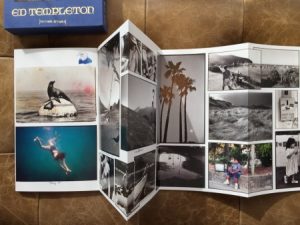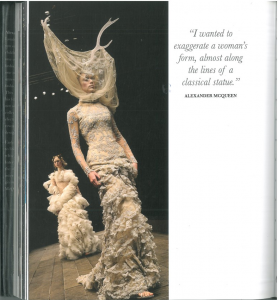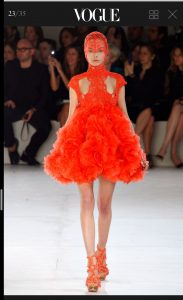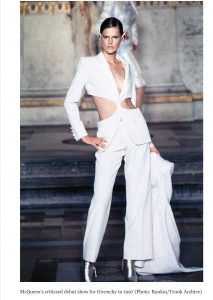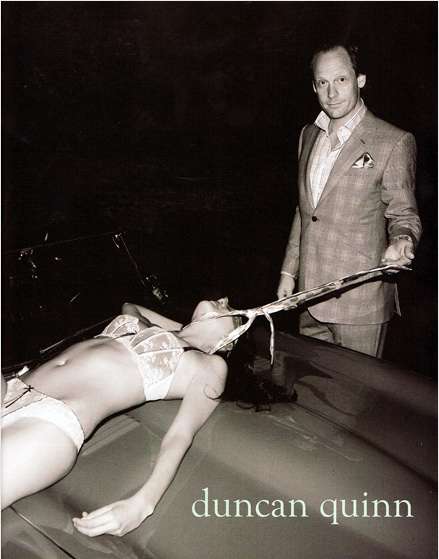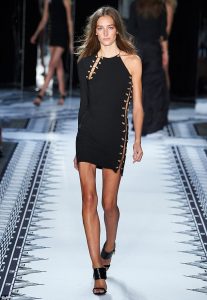Fashion advertising can be very controversial. Sometimes it’s not always clear what the advert is about and what they are selling.
For example, this advert by Duncan Quinn, I had to research the brand as it wasn’t clear to me what the advert was selling.
This advert is supposed to be selling bespoke men’s tailoring and accessories. But you’d have to look hard to find as it’s not obvious.
When I firstly looked at this advert I felt disgusted, my eyes were straight away drawn to the middle part of the advert where the tie is around the females’ neck. My eyes were then drawn to the male model with his posture and facial expression which explains a lot.
With this advert it shows the male domination and how he has power over her. But in the 21st century I don’t think this is at all politically correct. Seeing this brings out the feminism in me and how women should be treated and not as an object. Especially with this advert looking like she is a sex object or sex slave. It’s also showing the more sexual aspect to it, you could say it’s like something from a porn film or more recently Fifty Shades of Grey.
The female model doesn’t need to be in this advert at all in my eyes, it’s about male tailoring so she doesn’t need to be there. The posture of her is quite sad to look at, to me with the way he’s posing with the tie around her neck makes it look like she’s struggling or is dead, which is something which should not in a fashion advert whatsoever.
This advert is showing how he’s a possible criminal, it’s something like you read in the news. Where a male abducts a female, rapes her, then murders her. Treating her like an object, although like anyone else she has feelings and is a human being. It’s making this advert more current with the subjective meaning behind it.
The advert is sending out the wrong message, to think the amount of people who could view this makes me feel sick. Especially with the younger generations, as fashion adverts like this one can be viewed by literally anyone nowadays especially online or social media.
Overall with fashion adverts there shouldn’t be any violence or sexual content in them that’s what fashion shouldn’t be about, it should be about the clothes and accessories itself how you feel when you wear them, how they empower you and how you stand alone with your own individual trend different to anyone else’s. In the future this is what adverts should be about where it gives a positive message and encourages the younger generations growing up and coming into the industry how fashion adverts can be something good.
Category Archives: Fashion & Textile Design
Take 9/10 – Ethical issues in advertising
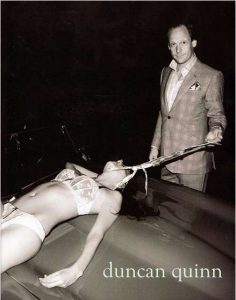 This is an advertisement for Duncan Quinn which is a menswear company which specialises in British tailoring and could be said to only used and produce the ‘best’. In the image there is a man dressed in a tailored suit with an amused look on his face on the right of the image. On the left of the image there is a slim woman who is in white lingerie lying on a car with what looks to be a leash around her neck. The woman looks subservient as well as unconscious due to her body looking limp and unresponsive which raises some red flags.
This is an advertisement for Duncan Quinn which is a menswear company which specialises in British tailoring and could be said to only used and produce the ‘best’. In the image there is a man dressed in a tailored suit with an amused look on his face on the right of the image. On the left of the image there is a slim woman who is in white lingerie lying on a car with what looks to be a leash around her neck. The woman looks subservient as well as unconscious due to her body looking limp and unresponsive which raises some red flags.
One ethical standard within advertising is to not mislead the consumer. In this image Duncan Quinn has objectified the woman into a submissive sex slave which doesn’t correspond to British menswear tailoring which misleads the consumer into not actually understanding the true point of the advert which was to promote Duncan Quinn as a menswear brand rather than sexual domination of men. In Gender and the media by R.Gill stated “turning a human being into a thing, an object, is almost always the first step towards justifying violence against that person” (Kilbourn 1999). This could be linked to the ‘victim blaming’ which is when something bad happens to a person but they, the victim, are blamed. This advert makes women seem more like sexual objects rather human beings and if something or someone is an object they will not be treated as another human being, creating one theory for why there is violence against women.
In advertising they are meant to mirror and reflect that society and if Duncan Quinn’s advert is meant to reflect society what does it say to the rest of the world about Britain and its men? That they’re dominant? Consumed with luxury and ego? That they care about themselves more than others? If so, this is quite evident by the way the man is treating the woman in the picture if you was to say that this image is a reflection of its society. This image is tailored towards the male gaze as it is directed at the ‘heterosexual man’ and the characteristics associated with the title. The woman is portrayed and treated as a sexual object in this picture which could also say that western societies do not view women as equals to men but rather sexual beings that satisfy men’s needs as this “woman’ is ‘depicted as ‘decorative object’” (R.Gill 2006) rather than a smart, intelligent, career bound with either a job or as a mother.
Overall, the image creates a false representation of western societies which violates ethics surrounding morals and misleading. The image can be considered offensive towards women as it portrays them as inferior and subservient to men and they are the ones in control because they are ‘holding the leash’. This is unethical because it incorrectly suggests that Duncan Quinn is about something other than British menswear tailoring.
Bibliography
Gill,Rosalind (2006) Gender in the media, Cambridge; Polity Press
Slideshare (2010) Available from https://www.slideshare.net/f098/ethical-issues-in-advertising [Accessed 25th November 2017]
Tasks 3 & 4: Academic Integrity
I chose to look at street photography for this task, although not directly linked to fashion and textile design, I think it’s important to observe and understand the people in our towns and cities, that these photographers capture so honestly and meaningfully, as much of today’s fashion comes from and is influenced by the everyday man and woman. An example being skate culture and the recent rise in the popularity of skate wear and skate brands among popular fashion.
The book I found to reference is a beautiful book by Ed Templeton. It is presented in an accordion style and documents his visits to the island of Santa Catalina off the coast of Southern California, in a series of candid but beautiful photographs of the places and people of Santa Catalina. These pictures really capture the carefree vibe Templeton must have experienced whilst visiting.
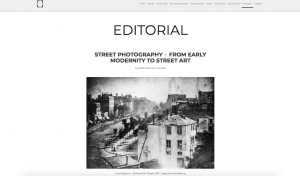
I then came across an editorial on street photography on the Open Walls Gallery website. Here they attempt to define street photography, highlighting the flexible nature of this particular genre of photography and its main objective which is to “be a true mirror of society” (Open Walls, 2016).
My third source, an article on the New York Times website about the skaters of Tompkins Square Park in New York City, documents the importance of the grittier areas of New York, and every major city, that are becoming increasingly gentrified, as a place to keep skate culture and the recognisable style that comes with it, alive.
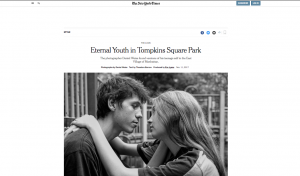
- E. Templeton, (2015), Adventures in the Nearby Faraway, Paris, Editions Bessard
- Open Walls Gallery, (2016), ‘Street Photography – From Early Modernity to Street Art’. Available from: https://openwallsgallery.com/street-art-photography/ (Accessed: 25/11/17)
- Theodore Barrow, (2017), ‘Eternal Youth in Tompkins Square Park’, The New York Times, 11 November. Available from: https://www.nytimes.com/2017/11/11/style/eternal-youth-in-tompkins-square-park.html?rref=collection%2Fcolumn%2Fthe-look (Accessed: 25/11/17)
Task 3/4 References
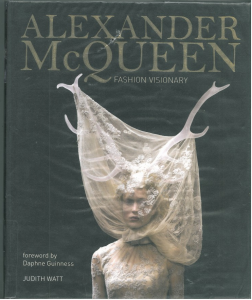 Watt, Judith (2012) Alexander McQueen Fashion Visionary published 2012 by Goodman books Limited, London
Watt, Judith (2012) Alexander McQueen Fashion Visionary published 2012 by Goodman books Limited, London
I was looking at the British fashion designers shelve on the library and come across this book, one of the most famous fashion designer in British and in fashion industry. I like to know and learn about the designer background and how they uses their experiences to develop their work and what influences their collections. Reading this book give me a lot of insight about the artist personality and who he really is as a person “he loved women, really adored them – and not just for their statuesque beauty, but for our fragility as well as our strength our ghosts and demons alongside our accomplishment” this make me realised that Alexander McQueen work is rare and he introduces new thing to fashion, some of his collection might be extremely outrageous and people might seen it and take it the wrong way while he’s just trying to empowering women and femininity.
This site shows Alexander McQueen spring 2012 ready to wear collection it’s a very well known created by Sarah Burton “she based her collection on the three Gs: Gres for the pleating and draping, Gaudi for the architecture, and Gaia for the sense of all-encompassing oceanic life that infused the clothes, like the outfits composed of coral or shells” i like the idea of the collection and the thoughts behind it is very thoughtful like the designer was not just thinking about the look but also the movements of the fabrics “Empire line of ruffles, which undulated as a models walked, “like a jellyfish moves in the sea” which i find what inspiring the most about the collection.
Vogue PLC (2011) Alexander McQueen Spring/Summer 2012 Ready-To-Wear Collection Available from: http://www.vogue.co.uk/shows/spring-summer-2012-ready-to-wear/alexander-mcqueen/collection [Accessed 20/10/17]
McQueen’s criticised debut show for Givenchy in 1997 (photo: Rankin/ Trunk Archive)
This online news article was wrote in 2015 about how Alexander McQueen got his name in the fashion industry. The article is about the collection that McQuuen collaborate with the brand Givenchy the collection is called “It’s a Jungle out there” which inspired by the television documentary on gazelles” the collection is interesting from where the inspiration begins in the first place, and how the designer interpret it in this way. I like the animal and fierce look in this collection I’ve learn from this article that ideas is unlimited and inspiration can come from many things and can always turned into an art work if you do it with passion.
References:
1. Watt, Judith (2012) Alexander McQueen Fashion Visionary published 2012 by Goodman books Limited, London
2. Vogue PLC (2011) Alexander McQueen Spring/Summer 2012 Ready-To-Wear Collection Available from: http://www.vogue.co.uk/shows/spring-summer-2012-ready-to-wear/alexander-mcqueen/collection [Accessed 20/10/17]
3. Thomas. DANA (2015) Alexander McQueen: The fashion show that made his name. Telegraph 14th February.
Task 9/10- Ethics
The advertisement which I have chosen to analyse is the suit campaign advert for Duncan Quinn. I have chosen to look further into this advert as I find it the most disturbing and degrading out of the two images.
Unlike in the American Apparel advert, where the lady had control of herself and her actions, in this Duncan Quinn advert the female looks inferior and submissive under the control of a man. The advert shows a well dressed and smug looking man, pulling a lady in sexy lingerie across the bonnet of his car by the head. The way he is controlling her reminds me of a way you would control your dog when it is on a lead. He is very much in control as she is in a vulnerable state. The way the ladies hand looks limp and the shadowing around her head could suggest that the lady has been killed by the man in the image. His smug look on his face shows his enjoyment and pleasure of the power he is holding over lady. A stylish expensive suit, a posh American style vintage car and the pride on his face all indicate that he is a wealthy and important man. Her submissive pose and lack of clothing shows that she is unimportant. As this is an advert for a male suit campaign it makes it worse for me. Duncan Quinn is portraying to his audience that you can be this man if you wear one of my suits. As if he is proud to say that is ok to control women if you are wealthy and powerful enough to own a Duncan Quinn suit.
The woman being in her underwear gives the impression of a sex slave. Someone who is raped and forced to be submissive to the superior male. The way in which the photograph has been shot also gives a more sinister feeling to the whole image. The whole focus is on the lady, the car and the male. Around them is incredibly dark and mysterious. You don’t know where they are or who else is there. It gives off the impression they could be in a garage or parked outside in a more rural area at night. Adding the black and white filter to the image takes away all happiness and life from the photo. Instead it is dark, cruel and uninviting.
‘Research has shown that violence against women is a serious public health and human rights concern (World Health Organization 2000) and that the simultaneous presentation of women as sex objects and victims in various forms of media increases acceptance of violence against women (Malamuth et al. 2000)’ This quote from the article ‘Women as Sex Objects and Victims in Print Advertisements’ has made me think about the impact which media has on the world. After seeing this advert men may feel that is has become more acceptable to treat women in this way. The power of this man could be tempting to the male audience due to his wealth and appearance. I believe that this advert should have been banned as there are so many different ways which it could be interpreted badly. There are many other adverts which have been banned from certain countries which I feel are far less graphic and discriminating. For example the Marc Jacobs ‘Lola’ perfume advert was banned from the US for complaints about ‘sexualising children’ after using actress Dakota Fanning in a girly/ childlike dress.
Task 7/8- Fashion as Communication
Fashion as communication is the book I have chosen to reflect upon for this task. In the chapter ‘Etymologies and Definitions of Fashion and Clothing’ Malcom Bernard looks in depth at the meaning of fashion and the way fashion has been used in society. In the opening Bernard explains that fashion was once something which someone done, unlike now, where fashion is something that someone wears. Throughout the chapter he expands on this thought as well as how fashion changes social status and peoples opinions towards fashion as a craft.
The passage of the chapter which I found most interesting, Bernard talks about how Fashion design ‘enjoys a lower status than any of the so-called fine arts’ (1996, Bernard, p.23) he backs up this quote with one similar from Willson ‘fashion is the degraded or unacceptable face of art’ (1990, p.209). After reading this chapter I was faced with the question ‘what is my perception of fashion?’. My initial thought was fashion is a form of wearable art. I noticed that this thought disagrees with Bernard’s and Willson’s feeling towards fashion. The oxford dictionaries definition of art states that art is ‘The expression or application of human creative skill and imagination, typically in a visual form such as painting or sculpture, producing works to be appreciated primarily for their beauty or emotional power’. Art is appreciated for their beauty or power in the same way fashion can make people feel beautiful or powerful. Fashion gives people different feelings as they wear it. The same way that art gives people different feelings as they study it. Dance, literature and music are also considered one of the arts. This is because they convey emotions. You either like or dislike certain genres of the arts the very same way that people like or dislike styles of fashion.
A debate by the Tate questions ‘is art changing the face of fashion?’ stating ‘the Piet Mondrian paintings that inspired Yves Saint Laurent’s Mondrian Collection of now iconic cocktail dresses in 1965’ (Tate, Holtham, 2013). The way art has such a big impact on fashion shows the close relation between art and fashion. Artists and designers are both very creative people therefor designers grasp the deeper meaning of art and translate it into their own. I came across a quote by Hugo Pratt ‘The fact is that even art is subject to fashion’. This made me think about how fashion is also changing the face of art. The styles of artist have changed throughout history to fit in with the fashion of today’s society. Even in the form of tattoos, the artwork that people choose to put on their bodies, change with the fashion of today’s world.
I feel that this chapter has opened my eyes to what fashion is and made me think about how it is perceived in today’s society. Although I disagree with some of the points in the writing, I found it incredibly interesting to see how others see fashion.
http://www.tate.org.uk/context-comment/blogs/tate-debate-art-changing-face-fashion, Susan Holtham, Feb 2013
Task 9/10 – Ethical Issues
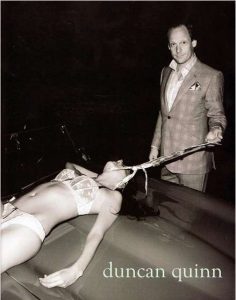
The ad I chose was for a tailoring advertisement by Duncan Quinn who is a luxurious British tailor. This ad caused a major controversy in the media because of its provocative view on women. I felt that the image had no relation to the main subject of the advertisement, to me the image is disturbing.
I thought that this ad was very controversial, as it shows a lifeless woman in her underwear dragged across a bonnet of a car while the man holds a neck tie around her body. The image seems to call out male domination over women because of how both are dressed very differently and also how they are positioned, the man being above the woman shows power whereas the woman’s position is seen as being submissive. The man in the image is dressed in a full outfit with a smug smile to his face and in comparison to the woman she wears nothing but her bra and pants. This clearly shows how women are used as sex objects for men. As well as the man’s facial expression the image gives off a sinister feeling due to the whole image being black and white, the background being in pitched black suggests that this was taking place at night-time where it would have been quieter and fewer people around. The ad overall shows a misogynistic and sexist approach towards women in which pushes ethical boundaries.
Furthermore, I read a book which talks about gender and culture and under a section on ‘Women as Victims and Sex Objects/Men as Aggressors’ the beginning of the paragraph states that “in media’s representation of relationships is that women continue to be portrayed as sex objects for men’s pleasure. In this representation, the very qualities women are encouraged to develop (beauty, sexiness, passivity, and powerlessness) in order to meet cultural ideals of femininity contribute to objectifying and he dehumanizing them.” With the pressure of having the ideal beauty and body in society for women, it encourages them to change their appearance in order to look like the “perfect woman” as they feel they don’t look good enough and as a result women feel like they’re finally part of the “cultural ideals”. This then adds to the factor of men objectifying women to seeing them as perfect women. As well as advertising for men, the goal or image that is associated would be based around hyper masculinity and violence. Additionally, games and music video show portrayals of objectifying women on a high scale. Popular video games tend to use violence as a way to win at the end. An example, Grand Theft Auto V is known for its violence and high crime game plot, the women in this game play a part of being strippers in which they get money thrown at or being prostitutes to be picked up and get killed. As well as music videos especially in rap videos women are seen dancing provocatively and wearing less clothes. These are the kind of factors that insinuate men to think it’s okay to objectify women, to an extent where young teenagers may even be influenced.
Bibliography:
[1] Wood, J.T., (2009) Gendered lives. Communication, Gender and Culture. Boston, Wadsworth.
Task 7/8 – Reflective Writing
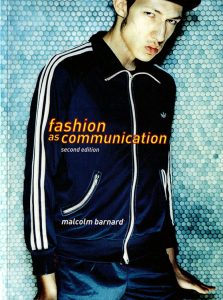 For the reflective writing task, I chose to read a chapter about ‘Etymology and the definitions of fashion and clothing’ from the Fashion as Communication book. This chapter explains the etymology of the word ‘fashion’, which comes from the latin word ‘factio’ which means making or doing something. The introduction of the chapter gave me an in-depth explanation of how the word ‘fashion’ relates to different terms. It looks into how associating words like “adornment”, “style” and “dress” can change the meaning of ‘fashion’.
For the reflective writing task, I chose to read a chapter about ‘Etymology and the definitions of fashion and clothing’ from the Fashion as Communication book. This chapter explains the etymology of the word ‘fashion’, which comes from the latin word ‘factio’ which means making or doing something. The introduction of the chapter gave me an in-depth explanation of how the word ‘fashion’ relates to different terms. It looks into how associating words like “adornment”, “style” and “dress” can change the meaning of ‘fashion’.
Reading through the chapter I came across the section about ‘Fashion and Anti Fashion’, which explains some of the aspects in which fashion takes place in the social and cultural status. The Royal family shows a good example of how they dress in a fashion and anti-fashion way. Taking into account Queen Elizabeth’s coronation gown which is an example of ‘Anti Fashion’. Polhemus and Procter suggests that it was ‘traditional’ and ‘fixed’ (Polhemus and Procter 1978). This is because the gown was designed for the “continuity” of her reign. Due to her high status, it is important that she is dressed anti fashion to show her position in the social scale, and remaining the same throughout the years to give a message of “continuity”. Whereas Princess Diana was described as “a one-woman advertisement”, she was seen as wearing “fashion”. I agree with the statement that she wears “it” as she has built an identity through the use of her own style and consistent image of a modern woman throughout her lifetime. I found a book that talks about dress and gender with a quote, “An emblem of peer, one’s position may be communicated by a crown, a staff, or a robe” which link quite well with the Queen’s “anti fashion” and her place in the social scale. I found another quote from a different book ‘Fashion Theory: An Introduction’ n it stated that “we have to use something with which to communicate and we must use something with which to construct ourselves as unique and individual member of cultures.” This also relates to Princess Diana as an example of someone who was widely known for her unique style and in which she used fashion to communicate with people around her.
Furthermore, a quote in the chapter that I thought was important “a garment is not an item of fashion until someone uses it to indicate their actual or ideal place in a social structure”, I feel that this stands in today’s western complex society, people who are in a higher status tend to use luxury fabrics and branded clothing. I noticed this links to Simmel’s idea of “primitive” and “civilised” society. In a place where there are social cultural groups there’s pressure in dressing right as opposed to “primitive” society where there is little pressure on expressing their individuality and in a way they’re all equal, therefore the way they dress would not be fashion.
Analysing further, I came across a part of the chapter which talks negatively about fashion, this was a quote written by Elizabeth Wilson found in The Guardian. “Fashion is trivial and ridiculous and serious minds need not to be detained by it”, this quote clearly dismisses fashion and doesn’t believe that it is a serious topic which I completely disagree with because fashion largely contributes to the UK’s economy.
Bibliography:
[1] Bardnard, M (2002) Fashion As Communication, London: Routledge
[2] Barnes, M and Eicher, J. B. (1992) Dress and Gender: Making and Meaning in Cultural Contexts. Vol 2. Oxford: Berg.
[3] Barnard, M., (2014). Fashion theory: An introduction. Routledge.
Task 1/2 Research Process
Versace
 Evening gowns, spring- summer 1994. Black silk with silver and gold- tone- metal safety- pin ornaments. Courtesy Gianni Versace Archives
Evening gowns, spring- summer 1994. Black silk with silver and gold- tone- metal safety- pin ornaments. Courtesy Gianni Versace Archives
Gianni Versace published by the Metropolitan Museum of Art, New York 1997
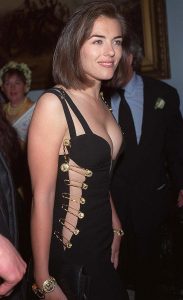 I chose to look at the designer book Gianni Versace and chosen this image as i think the dress is very iconic creation and have been worn for the first time by the famous model Liz Hurley in 1994. In the book shows this dress on the mannequin showing the cut out details and oversized gold safety pins ornaments held together the cut out. “The dress is said to be punk- inspired, “neo-punk”. This dress that the designer Versace made had made the model Liz Hurley become recognisable as the “dress received considerable global coverage in newspaper and magazines around the world” The model benn credited for making the Versace fashion brand a household name. This dress also been worn by famous singer Lady Gaga in 2010.
I chose to look at the designer book Gianni Versace and chosen this image as i think the dress is very iconic creation and have been worn for the first time by the famous model Liz Hurley in 1994. In the book shows this dress on the mannequin showing the cut out details and oversized gold safety pins ornaments held together the cut out. “The dress is said to be punk- inspired, “neo-punk”. This dress that the designer Versace made had made the model Liz Hurley become recognisable as the “dress received considerable global coverage in newspaper and magazines around the world” The model benn credited for making the Versace fashion brand a household name. This dress also been worn by famous singer Lady Gaga in 2010.
Versace is very well known about their signature gold baroque motifs printed design on silk fabrics, I think that this dress is another signature design and revolutionary back in 1994 after the little black dress by Chanel in 1920s the designer Versace took this to another level the cut out detail with the gold safety pins fastenings sexy and sophisticated at the same time the slit detail let the skin peak through the garment but not too much cleavage being exposed giving women the confident to express themselves through the invention of the designer and their intention of the design.
I’ve found this similar style black dress that the Versace in a short bodycon style with one long sleeve on the right side with a halter neck line. The design of the dress is more current less revealing but still very sophisticated and more high fashion compare to the other one which looks more classy i think because of the longer lenght of the dress, an how it been worn by the model to the event at that time. This dress was cut split on the side and by the shoulder seam just a glimpse of leg and cleavage and was held together by clasps instead of a safety pins which i think makes the spacing between the dress narrower and shows less skin. This similar dress was created by the same brand Versace in 2o years later after “That Dress” was made it’s interesting to see how the designer change the styling of the dress play with the shape of the garment but kept the same iconic feature which what make the dress famous and well known is the gold metal safety pins, or clasps that make the simple black dress into something more specials and recognisable. The brand has created their iconic look which can’t be copied with this features can be uses in so many different ways like skirts, tops, etc which I’ve seeen and similar to Chanel jackets which the brand uses tweed fabrics to ceates so many different styles of clothing which i would still recognise it was made by Chanel even without the logo because of what was created by the designer in the first place in the past.
Refernces:
1. Gianni Versace published by the Metropolitan Museum of Art, New York 1997
2. Williams, Amanda 2014 “THAT dress is back… and this time it’s even racier than ever: New safety pin Versace dress first worn by Liz Hurley hits runway at New York Fashion week“ http://www.dailymail.co.uk/femail/article-2750197/THAT-dress-time-racier-New-safety-pin-Versace-dress-worn-Liz-Hurley-hits-runway-New-York-Fashion-week.html [11/25/17]
Task 7/8: Fashion as Communication
The book ‘Fashion as Communication’, written by Malcolm Barnard discusses key debates within the concept of fashion.
Primarily, Barnard discusses the difference between ‘fashion’ and ‘anti-fashion’. Within this, Simmel believes that for fashion to be established, there are ‘two social tendencies’: being in union with society but maintaining your social identity. The text then includes explanations from Polhemus and Procter about the definitions of ‘anti-fashion’ in contrast to ‘fashion’; ‘anti- fashion’ is a ‘symbol of continuity’ whereas fashion is constantly changing with each season. Moreover, Burnard discusses how fashion is seen by some as ‘trivial pursuits’ and that ‘serious-minded people’ see it as an unimportant subject. Braudel’s disagree with this, stating that fashion ‘touches on every issue – raw materials, production processes…’ (Braudel 1981:311). Furthermore, the text discusses how the word ‘design’ is perceived to have a lower status in European culture than ‘art’. Some believe that in order for fashion to have a higher status, it would have to change its name to something with the word ‘art’ in such as ‘applied arts’.
The understanding of the difference between ‘fashion’ and ‘anti –fashion’ is agreed upon by James Laver (1899) and Charlies Baudelaire (1821) in ‘Fashion Media: Past and Present’. Laver stated that fashion is contemporary in comparison to costume and Baudelaire explained that fashion is modernity; ‘the transient, the fleeting, the contingent: it is one half art, the other being the eternal and the immovable’ (Baudelaire 1972: 403)
Elise Leveque disagrees with Art having a higher rank than Design and states they have equal ranks; ‘both designers and artists create their own visual interpretations and compositions with the skills and knowledge set they have’. Leveque concludes the two are equal but have ‘a different set of aesthetic values’. (thedeependdesign, 2013)
I agree that art and design are two separate subjects so they can’t be compared so closely as to give one a higher rank than the other. I believe that design is important as it makes up everything around us. From a table we sit at to an artist’s canvas, everything has to be designed first. Furthermore, Fashion Design, which is just one area of design, is a huge contribution to the economy and society, as Braudel stated. The United States congress stated that ‘Fashion is a $1.2 trillion global industry’. (The Economic Impact of the Fashion Industry, 2015)
I disagree that fashion is trivial. Burnard writes that ‘serious-minded’ and intelligent people are uninterested in fashion. Although I agree there are important issues to worry about such as the starving populations in Africa or global warming, I believe fashion shouldn’t be devalued as a subject. Fashion allows economy to thrive and society to identify themselves. I believe it is contradictory for serious-minded, intelligent people to say fashion is trivial as I think it’s less intelligent for them to agree with each other rather than having their own opinions. The importance of fashion is highlighted by Gerda Buxbaum in the opening of ‘Fashion in Context’. Buxbaum states that fashion embodies a large variety of topics such as ‘myth, lifestyle, gender, bodies in consumer culture… uniformity, identity (and its loss).’
I believe the first chapter of ‘Fashion as Communication’ brought up key issues within fashion which was interesting to acknowledge and reflect upon. It is clear that fashion and the place it has in the economy and society is vitally important.
Bibliography:
Barnard, M, (2002), ‘Fashion as Communication’, 2nd edition, Routledge
Buxbaum, G, (2009), ‘Fashion in Context‘, Springer Vienna Architecture
Bartlett, D, (2013), ‘Fashion Media: Past and Present‘, Bloomsbury Academic
Leveque, E, (2013), thedeependdesign.com, Available from: http://thedeependdesign.com/art-vs-graphic-design-the-debate-rages-on/
Maloney, C. B, (2015), Joint Economic Committee: United States Congress, Available from: https://maloney.house.gov/sites/maloney.house.gov/files/documents/The%20Economic%20Impact%20of%20the%20Fashion%20Industry%20–%20JEC%20report%20FINAL.pdf



